BMO1102: Motivation, Expectancy Theory, and Academic Performance Essay
VerifiedAdded on 2022/12/14
|8
|2119
|54
Essay
AI Summary
This essay delves into the critical role of motivation within the context of organizational behavior, focusing on its impact on individual actions, goals, and willingness to achieve. It emphasizes how motivation influences behavior, learning, and cognitive processing. The essay explores the significance of both extrinsic and intrinsic motivation, and then examines Vroom's Expectancy Theory, detailing its three key elements: valence, expectancy, and instrumentality. It provides a personal reflection on how the application of expectancy theory improved the author's academic performance. The analysis highlights how understanding and applying these motivational theories, especially in the academic setting, can lead to enhanced student performance and achievement. The essay concludes by reinforcing the importance of continuous assessment of motivation levels through personal interactions and the provision of extrinsic motivators to foster a competitive and successful academic environment.
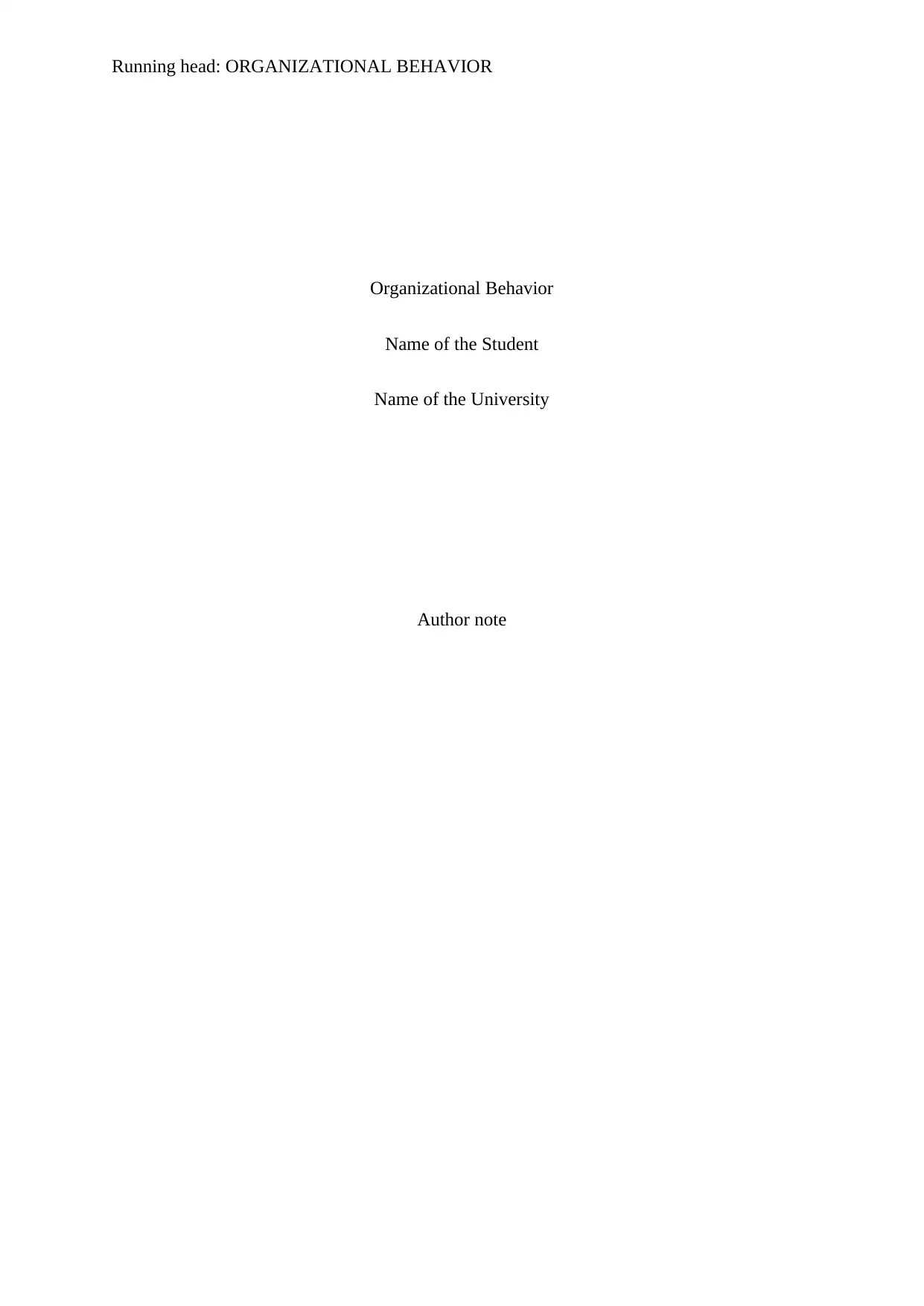
Running head: ORGANIZATIONAL BEHAVIOR
Organizational Behavior
Name of the Student
Name of the University
Author note
Organizational Behavior
Name of the Student
Name of the University
Author note
Paraphrase This Document
Need a fresh take? Get an instant paraphrase of this document with our AI Paraphraser
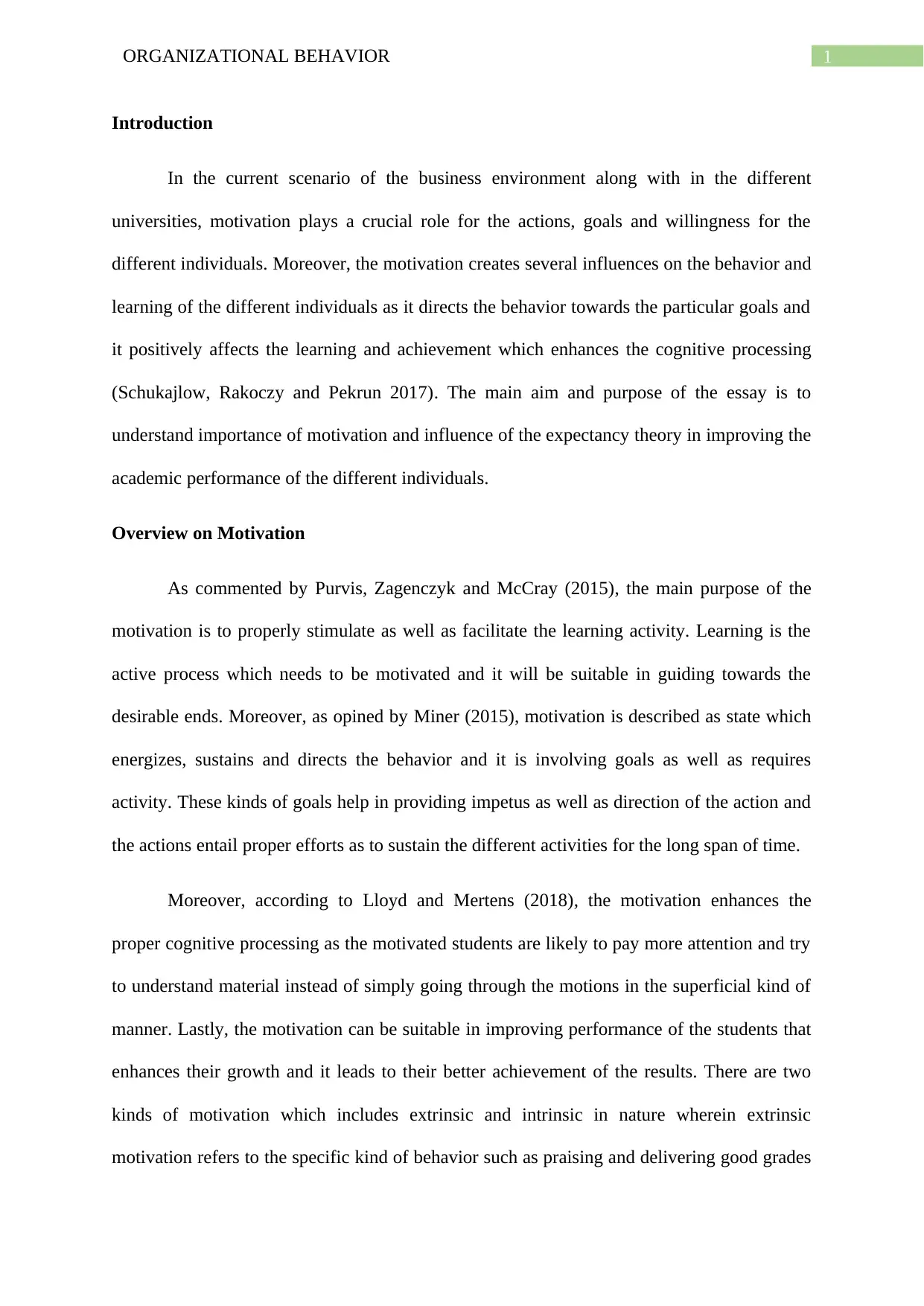
1ORGANIZATIONAL BEHAVIOR
Introduction
In the current scenario of the business environment along with in the different
universities, motivation plays a crucial role for the actions, goals and willingness for the
different individuals. Moreover, the motivation creates several influences on the behavior and
learning of the different individuals as it directs the behavior towards the particular goals and
it positively affects the learning and achievement which enhances the cognitive processing
(Schukajlow, Rakoczy and Pekrun 2017). The main aim and purpose of the essay is to
understand importance of motivation and influence of the expectancy theory in improving the
academic performance of the different individuals.
Overview on Motivation
As commented by Purvis, Zagenczyk and McCray (2015), the main purpose of the
motivation is to properly stimulate as well as facilitate the learning activity. Learning is the
active process which needs to be motivated and it will be suitable in guiding towards the
desirable ends. Moreover, as opined by Miner (2015), motivation is described as state which
energizes, sustains and directs the behavior and it is involving goals as well as requires
activity. These kinds of goals help in providing impetus as well as direction of the action and
the actions entail proper efforts as to sustain the different activities for the long span of time.
Moreover, according to Lloyd and Mertens (2018), the motivation enhances the
proper cognitive processing as the motivated students are likely to pay more attention and try
to understand material instead of simply going through the motions in the superficial kind of
manner. Lastly, the motivation can be suitable in improving performance of the students that
enhances their growth and it leads to their better achievement of the results. There are two
kinds of motivation which includes extrinsic and intrinsic in nature wherein extrinsic
motivation refers to the specific kind of behavior such as praising and delivering good grades
Introduction
In the current scenario of the business environment along with in the different
universities, motivation plays a crucial role for the actions, goals and willingness for the
different individuals. Moreover, the motivation creates several influences on the behavior and
learning of the different individuals as it directs the behavior towards the particular goals and
it positively affects the learning and achievement which enhances the cognitive processing
(Schukajlow, Rakoczy and Pekrun 2017). The main aim and purpose of the essay is to
understand importance of motivation and influence of the expectancy theory in improving the
academic performance of the different individuals.
Overview on Motivation
As commented by Purvis, Zagenczyk and McCray (2015), the main purpose of the
motivation is to properly stimulate as well as facilitate the learning activity. Learning is the
active process which needs to be motivated and it will be suitable in guiding towards the
desirable ends. Moreover, as opined by Miner (2015), motivation is described as state which
energizes, sustains and directs the behavior and it is involving goals as well as requires
activity. These kinds of goals help in providing impetus as well as direction of the action and
the actions entail proper efforts as to sustain the different activities for the long span of time.
Moreover, according to Lloyd and Mertens (2018), the motivation enhances the
proper cognitive processing as the motivated students are likely to pay more attention and try
to understand material instead of simply going through the motions in the superficial kind of
manner. Lastly, the motivation can be suitable in improving performance of the students that
enhances their growth and it leads to their better achievement of the results. There are two
kinds of motivation which includes extrinsic and intrinsic in nature wherein extrinsic
motivation refers to the specific kind of behavior such as praising and delivering good grades
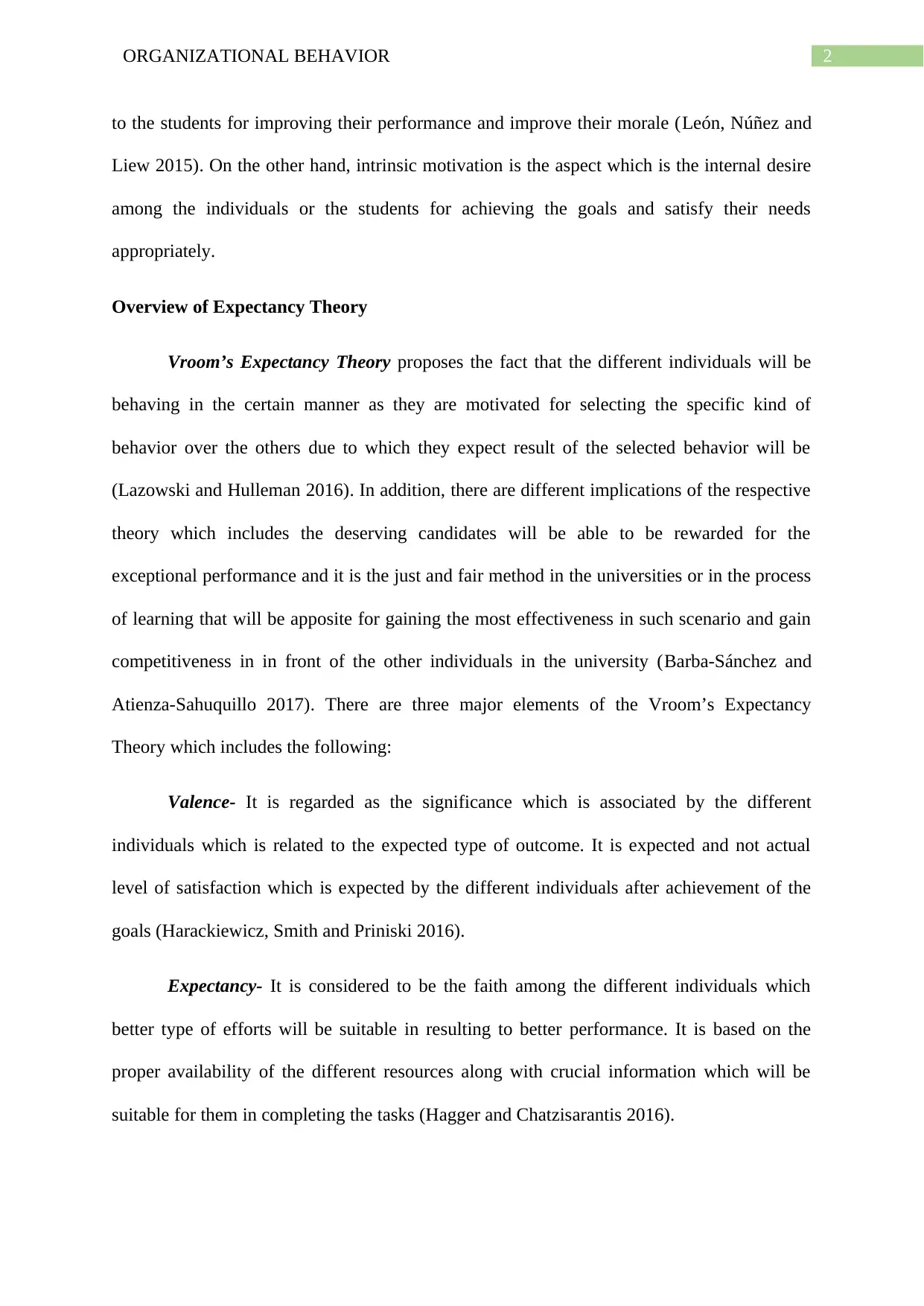
2ORGANIZATIONAL BEHAVIOR
to the students for improving their performance and improve their morale (León, Núñez and
Liew 2015). On the other hand, intrinsic motivation is the aspect which is the internal desire
among the individuals or the students for achieving the goals and satisfy their needs
appropriately.
Overview of Expectancy Theory
Vroom’s Expectancy Theory proposes the fact that the different individuals will be
behaving in the certain manner as they are motivated for selecting the specific kind of
behavior over the others due to which they expect result of the selected behavior will be
(Lazowski and Hulleman 2016). In addition, there are different implications of the respective
theory which includes the deserving candidates will be able to be rewarded for the
exceptional performance and it is the just and fair method in the universities or in the process
of learning that will be apposite for gaining the most effectiveness in such scenario and gain
competitiveness in in front of the other individuals in the university (Barba-Sánchez and
Atienza-Sahuquillo 2017). There are three major elements of the Vroom’s Expectancy
Theory which includes the following:
Valence- It is regarded as the significance which is associated by the different
individuals which is related to the expected type of outcome. It is expected and not actual
level of satisfaction which is expected by the different individuals after achievement of the
goals (Harackiewicz, Smith and Priniski 2016).
Expectancy- It is considered to be the faith among the different individuals which
better type of efforts will be suitable in resulting to better performance. It is based on the
proper availability of the different resources along with crucial information which will be
suitable for them in completing the tasks (Hagger and Chatzisarantis 2016).
to the students for improving their performance and improve their morale (León, Núñez and
Liew 2015). On the other hand, intrinsic motivation is the aspect which is the internal desire
among the individuals or the students for achieving the goals and satisfy their needs
appropriately.
Overview of Expectancy Theory
Vroom’s Expectancy Theory proposes the fact that the different individuals will be
behaving in the certain manner as they are motivated for selecting the specific kind of
behavior over the others due to which they expect result of the selected behavior will be
(Lazowski and Hulleman 2016). In addition, there are different implications of the respective
theory which includes the deserving candidates will be able to be rewarded for the
exceptional performance and it is the just and fair method in the universities or in the process
of learning that will be apposite for gaining the most effectiveness in such scenario and gain
competitiveness in in front of the other individuals in the university (Barba-Sánchez and
Atienza-Sahuquillo 2017). There are three major elements of the Vroom’s Expectancy
Theory which includes the following:
Valence- It is regarded as the significance which is associated by the different
individuals which is related to the expected type of outcome. It is expected and not actual
level of satisfaction which is expected by the different individuals after achievement of the
goals (Harackiewicz, Smith and Priniski 2016).
Expectancy- It is considered to be the faith among the different individuals which
better type of efforts will be suitable in resulting to better performance. It is based on the
proper availability of the different resources along with crucial information which will be
suitable for them in completing the tasks (Hagger and Chatzisarantis 2016).
⊘ This is a preview!⊘
Do you want full access?
Subscribe today to unlock all pages.

Trusted by 1+ million students worldwide
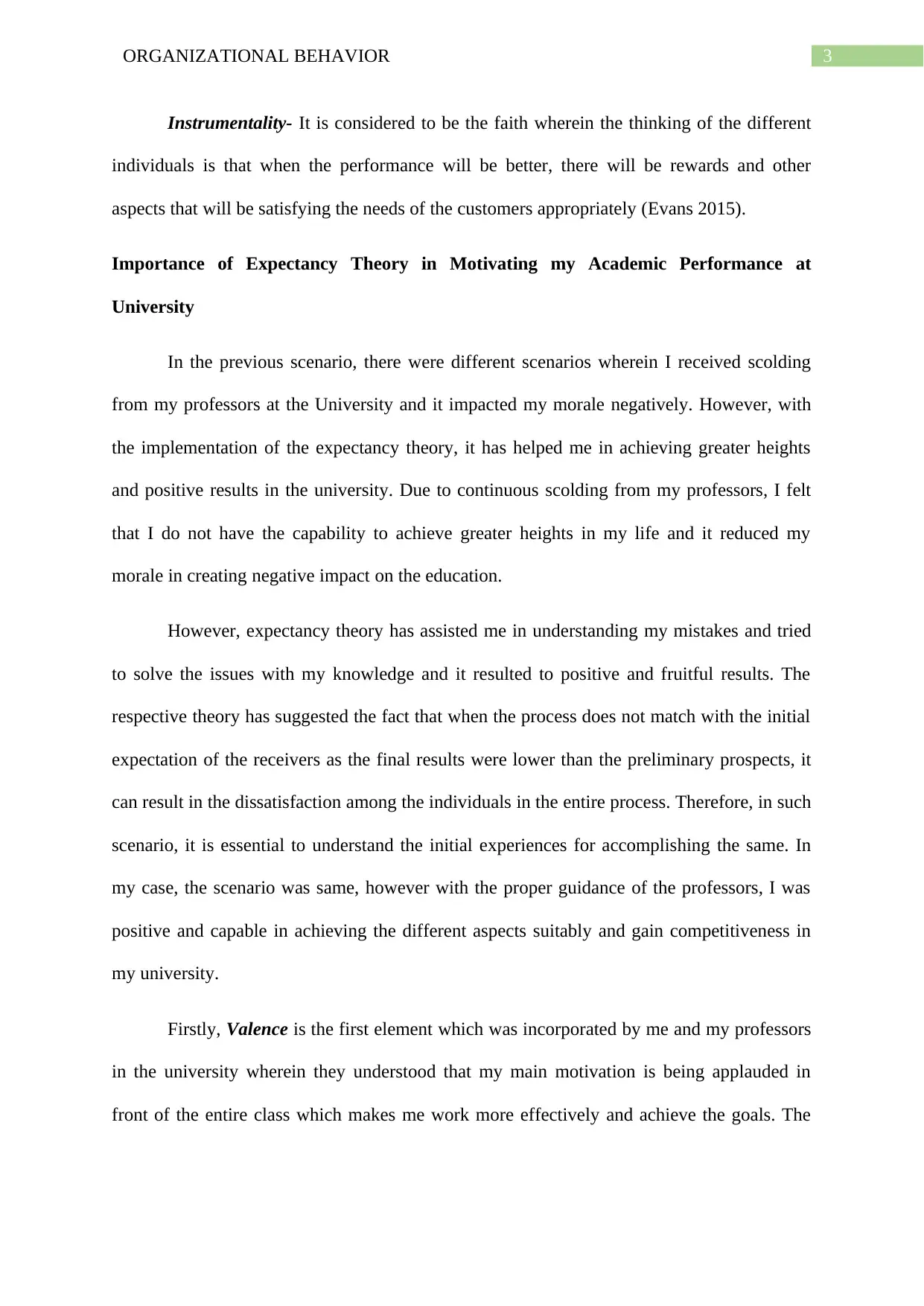
3ORGANIZATIONAL BEHAVIOR
Instrumentality- It is considered to be the faith wherein the thinking of the different
individuals is that when the performance will be better, there will be rewards and other
aspects that will be satisfying the needs of the customers appropriately (Evans 2015).
Importance of Expectancy Theory in Motivating my Academic Performance at
University
In the previous scenario, there were different scenarios wherein I received scolding
from my professors at the University and it impacted my morale negatively. However, with
the implementation of the expectancy theory, it has helped me in achieving greater heights
and positive results in the university. Due to continuous scolding from my professors, I felt
that I do not have the capability to achieve greater heights in my life and it reduced my
morale in creating negative impact on the education.
However, expectancy theory has assisted me in understanding my mistakes and tried
to solve the issues with my knowledge and it resulted to positive and fruitful results. The
respective theory has suggested the fact that when the process does not match with the initial
expectation of the receivers as the final results were lower than the preliminary prospects, it
can result in the dissatisfaction among the individuals in the entire process. Therefore, in such
scenario, it is essential to understand the initial experiences for accomplishing the same. In
my case, the scenario was same, however with the proper guidance of the professors, I was
positive and capable in achieving the different aspects suitably and gain competitiveness in
my university.
Firstly, Valence is the first element which was incorporated by me and my professors
in the university wherein they understood that my main motivation is being applauded in
front of the entire class which makes me work more effectively and achieve the goals. The
Instrumentality- It is considered to be the faith wherein the thinking of the different
individuals is that when the performance will be better, there will be rewards and other
aspects that will be satisfying the needs of the customers appropriately (Evans 2015).
Importance of Expectancy Theory in Motivating my Academic Performance at
University
In the previous scenario, there were different scenarios wherein I received scolding
from my professors at the University and it impacted my morale negatively. However, with
the implementation of the expectancy theory, it has helped me in achieving greater heights
and positive results in the university. Due to continuous scolding from my professors, I felt
that I do not have the capability to achieve greater heights in my life and it reduced my
morale in creating negative impact on the education.
However, expectancy theory has assisted me in understanding my mistakes and tried
to solve the issues with my knowledge and it resulted to positive and fruitful results. The
respective theory has suggested the fact that when the process does not match with the initial
expectation of the receivers as the final results were lower than the preliminary prospects, it
can result in the dissatisfaction among the individuals in the entire process. Therefore, in such
scenario, it is essential to understand the initial experiences for accomplishing the same. In
my case, the scenario was same, however with the proper guidance of the professors, I was
positive and capable in achieving the different aspects suitably and gain competitiveness in
my university.
Firstly, Valence is the first element which was incorporated by me and my professors
in the university wherein they understood that my main motivation is being applauded in
front of the entire class which makes me work more effectively and achieve the goals. The
Paraphrase This Document
Need a fresh take? Get an instant paraphrase of this document with our AI Paraphraser
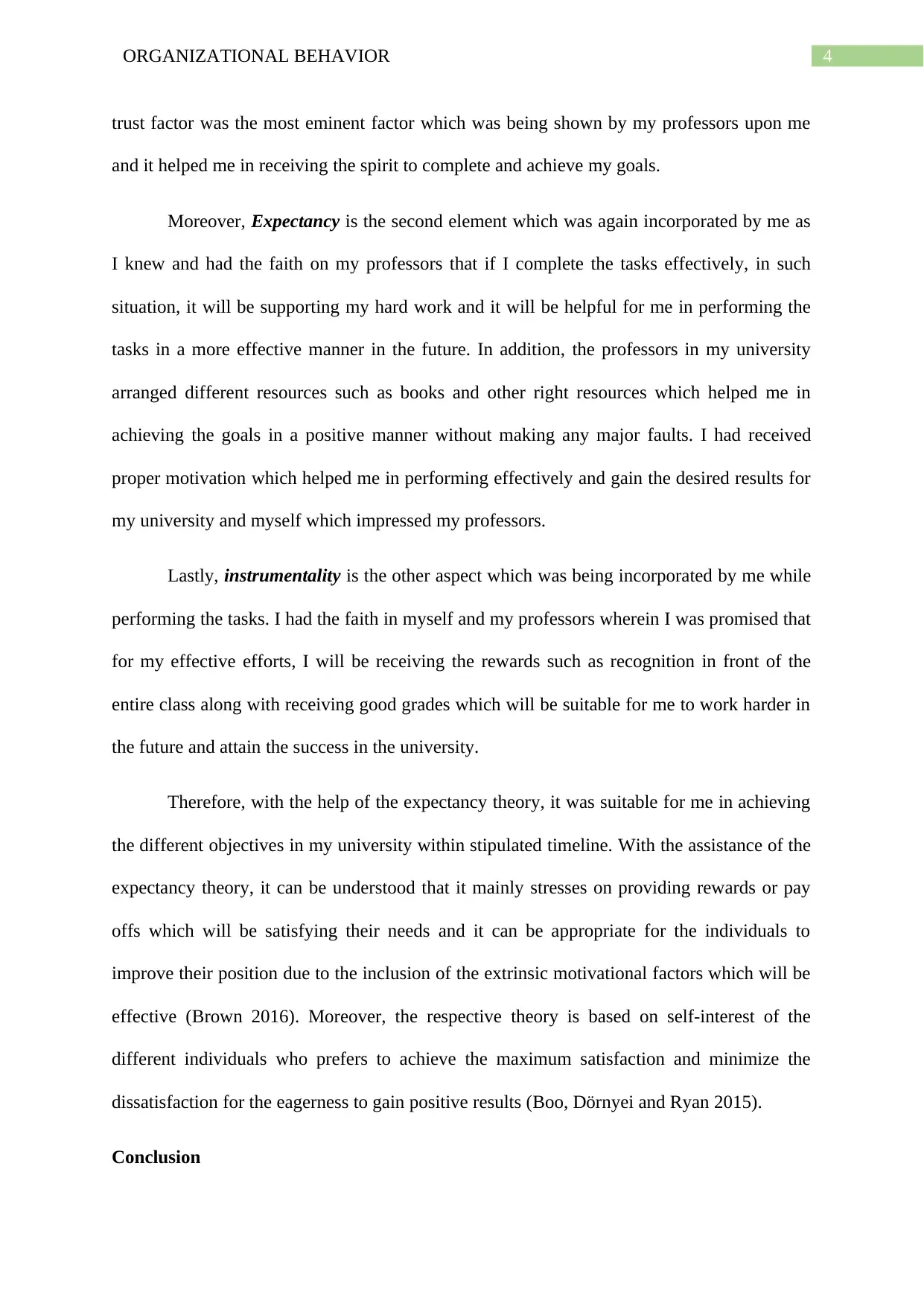
4ORGANIZATIONAL BEHAVIOR
trust factor was the most eminent factor which was being shown by my professors upon me
and it helped me in receiving the spirit to complete and achieve my goals.
Moreover, Expectancy is the second element which was again incorporated by me as
I knew and had the faith on my professors that if I complete the tasks effectively, in such
situation, it will be supporting my hard work and it will be helpful for me in performing the
tasks in a more effective manner in the future. In addition, the professors in my university
arranged different resources such as books and other right resources which helped me in
achieving the goals in a positive manner without making any major faults. I had received
proper motivation which helped me in performing effectively and gain the desired results for
my university and myself which impressed my professors.
Lastly, instrumentality is the other aspect which was being incorporated by me while
performing the tasks. I had the faith in myself and my professors wherein I was promised that
for my effective efforts, I will be receiving the rewards such as recognition in front of the
entire class along with receiving good grades which will be suitable for me to work harder in
the future and attain the success in the university.
Therefore, with the help of the expectancy theory, it was suitable for me in achieving
the different objectives in my university within stipulated timeline. With the assistance of the
expectancy theory, it can be understood that it mainly stresses on providing rewards or pay
offs which will be satisfying their needs and it can be appropriate for the individuals to
improve their position due to the inclusion of the extrinsic motivational factors which will be
effective (Brown 2016). Moreover, the respective theory is based on self-interest of the
different individuals who prefers to achieve the maximum satisfaction and minimize the
dissatisfaction for the eagerness to gain positive results (Boo, Dörnyei and Ryan 2015).
Conclusion
trust factor was the most eminent factor which was being shown by my professors upon me
and it helped me in receiving the spirit to complete and achieve my goals.
Moreover, Expectancy is the second element which was again incorporated by me as
I knew and had the faith on my professors that if I complete the tasks effectively, in such
situation, it will be supporting my hard work and it will be helpful for me in performing the
tasks in a more effective manner in the future. In addition, the professors in my university
arranged different resources such as books and other right resources which helped me in
achieving the goals in a positive manner without making any major faults. I had received
proper motivation which helped me in performing effectively and gain the desired results for
my university and myself which impressed my professors.
Lastly, instrumentality is the other aspect which was being incorporated by me while
performing the tasks. I had the faith in myself and my professors wherein I was promised that
for my effective efforts, I will be receiving the rewards such as recognition in front of the
entire class along with receiving good grades which will be suitable for me to work harder in
the future and attain the success in the university.
Therefore, with the help of the expectancy theory, it was suitable for me in achieving
the different objectives in my university within stipulated timeline. With the assistance of the
expectancy theory, it can be understood that it mainly stresses on providing rewards or pay
offs which will be satisfying their needs and it can be appropriate for the individuals to
improve their position due to the inclusion of the extrinsic motivational factors which will be
effective (Brown 2016). Moreover, the respective theory is based on self-interest of the
different individuals who prefers to achieve the maximum satisfaction and minimize the
dissatisfaction for the eagerness to gain positive results (Boo, Dörnyei and Ryan 2015).
Conclusion
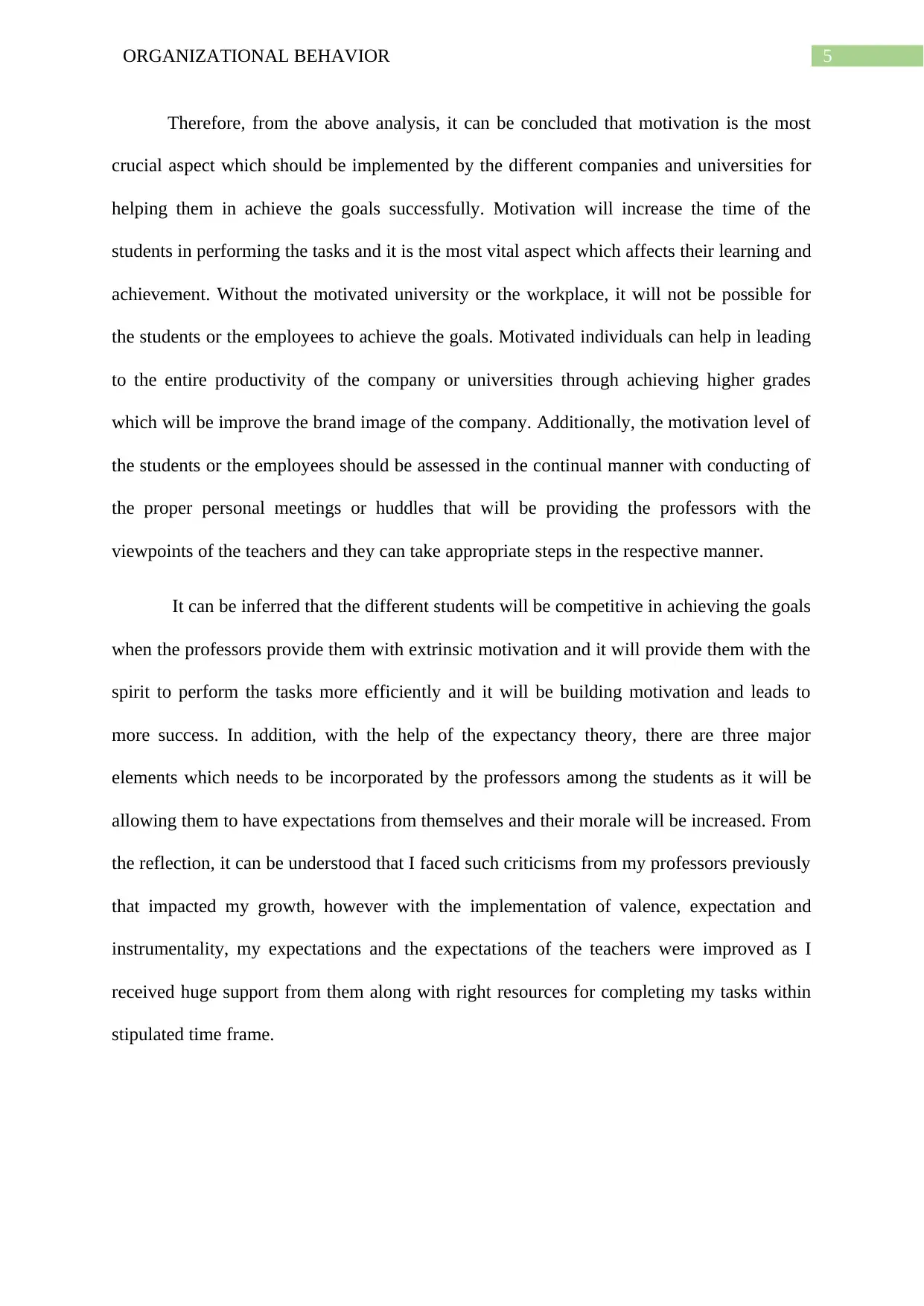
5ORGANIZATIONAL BEHAVIOR
Therefore, from the above analysis, it can be concluded that motivation is the most
crucial aspect which should be implemented by the different companies and universities for
helping them in achieve the goals successfully. Motivation will increase the time of the
students in performing the tasks and it is the most vital aspect which affects their learning and
achievement. Without the motivated university or the workplace, it will not be possible for
the students or the employees to achieve the goals. Motivated individuals can help in leading
to the entire productivity of the company or universities through achieving higher grades
which will be improve the brand image of the company. Additionally, the motivation level of
the students or the employees should be assessed in the continual manner with conducting of
the proper personal meetings or huddles that will be providing the professors with the
viewpoints of the teachers and they can take appropriate steps in the respective manner.
It can be inferred that the different students will be competitive in achieving the goals
when the professors provide them with extrinsic motivation and it will provide them with the
spirit to perform the tasks more efficiently and it will be building motivation and leads to
more success. In addition, with the help of the expectancy theory, there are three major
elements which needs to be incorporated by the professors among the students as it will be
allowing them to have expectations from themselves and their morale will be increased. From
the reflection, it can be understood that I faced such criticisms from my professors previously
that impacted my growth, however with the implementation of valence, expectation and
instrumentality, my expectations and the expectations of the teachers were improved as I
received huge support from them along with right resources for completing my tasks within
stipulated time frame.
Therefore, from the above analysis, it can be concluded that motivation is the most
crucial aspect which should be implemented by the different companies and universities for
helping them in achieve the goals successfully. Motivation will increase the time of the
students in performing the tasks and it is the most vital aspect which affects their learning and
achievement. Without the motivated university or the workplace, it will not be possible for
the students or the employees to achieve the goals. Motivated individuals can help in leading
to the entire productivity of the company or universities through achieving higher grades
which will be improve the brand image of the company. Additionally, the motivation level of
the students or the employees should be assessed in the continual manner with conducting of
the proper personal meetings or huddles that will be providing the professors with the
viewpoints of the teachers and they can take appropriate steps in the respective manner.
It can be inferred that the different students will be competitive in achieving the goals
when the professors provide them with extrinsic motivation and it will provide them with the
spirit to perform the tasks more efficiently and it will be building motivation and leads to
more success. In addition, with the help of the expectancy theory, there are three major
elements which needs to be incorporated by the professors among the students as it will be
allowing them to have expectations from themselves and their morale will be increased. From
the reflection, it can be understood that I faced such criticisms from my professors previously
that impacted my growth, however with the implementation of valence, expectation and
instrumentality, my expectations and the expectations of the teachers were improved as I
received huge support from them along with right resources for completing my tasks within
stipulated time frame.
⊘ This is a preview!⊘
Do you want full access?
Subscribe today to unlock all pages.

Trusted by 1+ million students worldwide
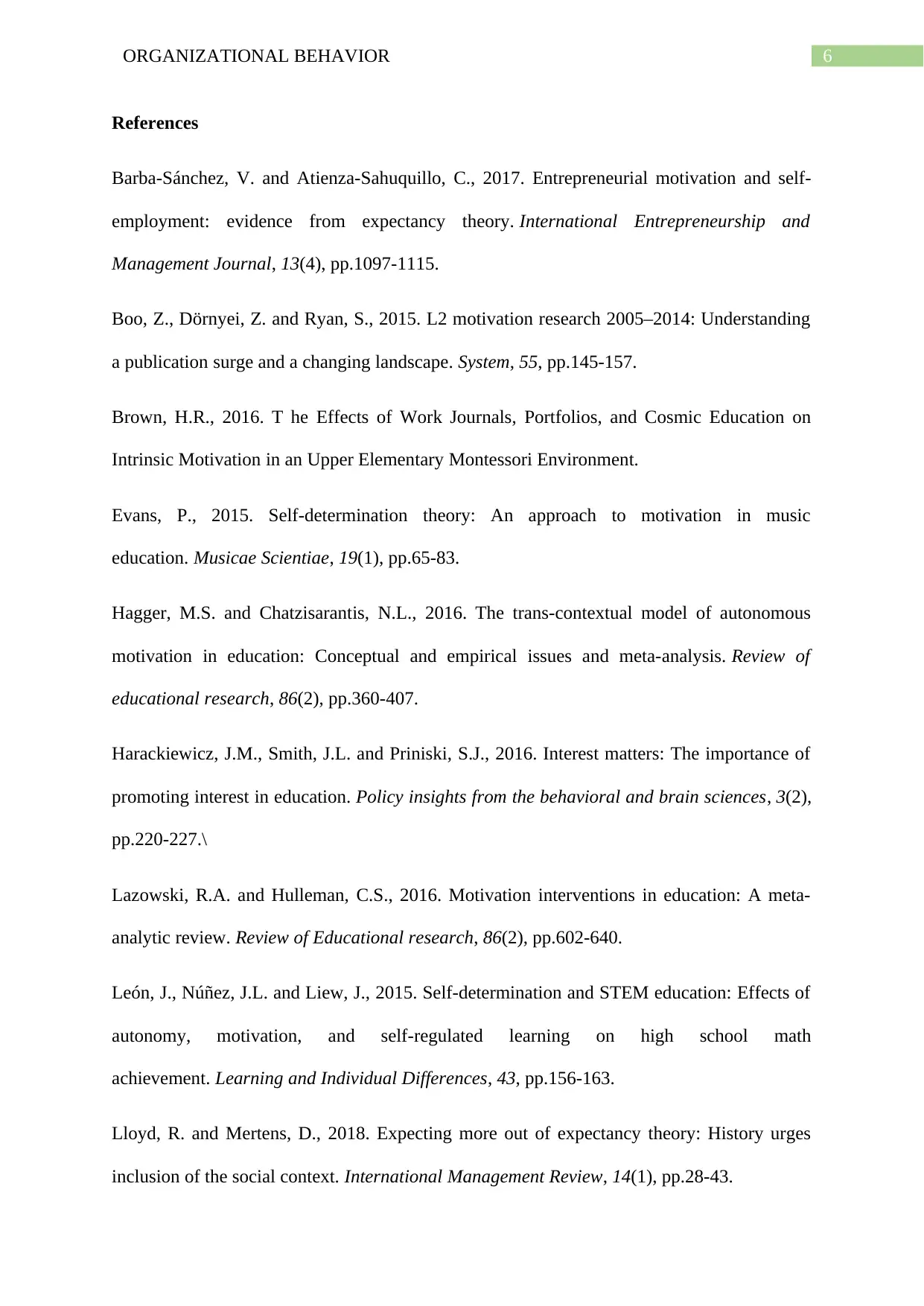
6ORGANIZATIONAL BEHAVIOR
References
Barba-Sánchez, V. and Atienza-Sahuquillo, C., 2017. Entrepreneurial motivation and self-
employment: evidence from expectancy theory. International Entrepreneurship and
Management Journal, 13(4), pp.1097-1115.
Boo, Z., Dörnyei, Z. and Ryan, S., 2015. L2 motivation research 2005–2014: Understanding
a publication surge and a changing landscape. System, 55, pp.145-157.
Brown, H.R., 2016. T he Effects of Work Journals, Portfolios, and Cosmic Education on
Intrinsic Motivation in an Upper Elementary Montessori Environment.
Evans, P., 2015. Self-determination theory: An approach to motivation in music
education. Musicae Scientiae, 19(1), pp.65-83.
Hagger, M.S. and Chatzisarantis, N.L., 2016. The trans-contextual model of autonomous
motivation in education: Conceptual and empirical issues and meta-analysis. Review of
educational research, 86(2), pp.360-407.
Harackiewicz, J.M., Smith, J.L. and Priniski, S.J., 2016. Interest matters: The importance of
promoting interest in education. Policy insights from the behavioral and brain sciences, 3(2),
pp.220-227.\
Lazowski, R.A. and Hulleman, C.S., 2016. Motivation interventions in education: A meta-
analytic review. Review of Educational research, 86(2), pp.602-640.
León, J., Núñez, J.L. and Liew, J., 2015. Self-determination and STEM education: Effects of
autonomy, motivation, and self-regulated learning on high school math
achievement. Learning and Individual Differences, 43, pp.156-163.
Lloyd, R. and Mertens, D., 2018. Expecting more out of expectancy theory: History urges
inclusion of the social context. International Management Review, 14(1), pp.28-43.
References
Barba-Sánchez, V. and Atienza-Sahuquillo, C., 2017. Entrepreneurial motivation and self-
employment: evidence from expectancy theory. International Entrepreneurship and
Management Journal, 13(4), pp.1097-1115.
Boo, Z., Dörnyei, Z. and Ryan, S., 2015. L2 motivation research 2005–2014: Understanding
a publication surge and a changing landscape. System, 55, pp.145-157.
Brown, H.R., 2016. T he Effects of Work Journals, Portfolios, and Cosmic Education on
Intrinsic Motivation in an Upper Elementary Montessori Environment.
Evans, P., 2015. Self-determination theory: An approach to motivation in music
education. Musicae Scientiae, 19(1), pp.65-83.
Hagger, M.S. and Chatzisarantis, N.L., 2016. The trans-contextual model of autonomous
motivation in education: Conceptual and empirical issues and meta-analysis. Review of
educational research, 86(2), pp.360-407.
Harackiewicz, J.M., Smith, J.L. and Priniski, S.J., 2016. Interest matters: The importance of
promoting interest in education. Policy insights from the behavioral and brain sciences, 3(2),
pp.220-227.\
Lazowski, R.A. and Hulleman, C.S., 2016. Motivation interventions in education: A meta-
analytic review. Review of Educational research, 86(2), pp.602-640.
León, J., Núñez, J.L. and Liew, J., 2015. Self-determination and STEM education: Effects of
autonomy, motivation, and self-regulated learning on high school math
achievement. Learning and Individual Differences, 43, pp.156-163.
Lloyd, R. and Mertens, D., 2018. Expecting more out of expectancy theory: History urges
inclusion of the social context. International Management Review, 14(1), pp.28-43.
Paraphrase This Document
Need a fresh take? Get an instant paraphrase of this document with our AI Paraphraser
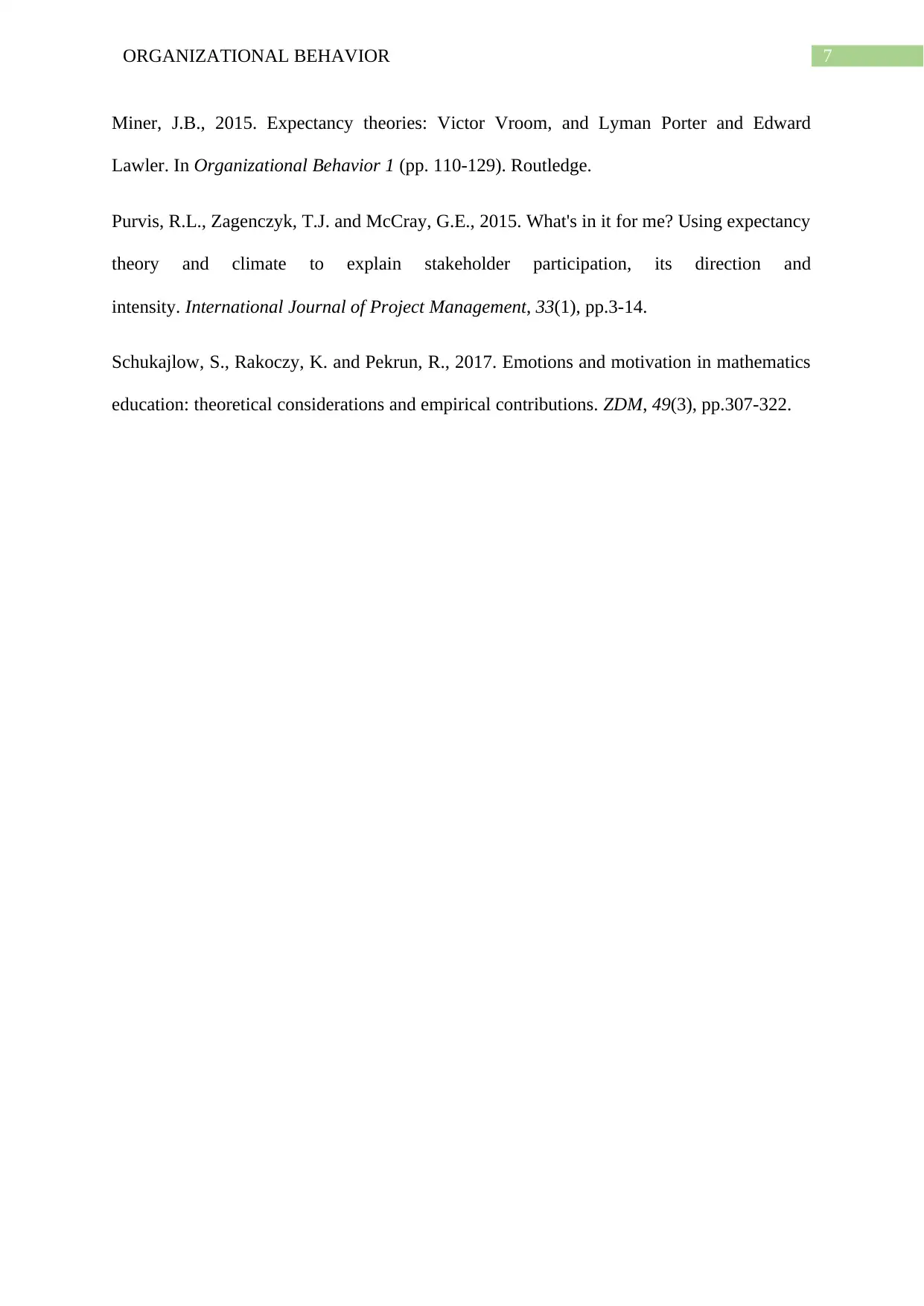
7ORGANIZATIONAL BEHAVIOR
Miner, J.B., 2015. Expectancy theories: Victor Vroom, and Lyman Porter and Edward
Lawler. In Organizational Behavior 1 (pp. 110-129). Routledge.
Purvis, R.L., Zagenczyk, T.J. and McCray, G.E., 2015. What's in it for me? Using expectancy
theory and climate to explain stakeholder participation, its direction and
intensity. International Journal of Project Management, 33(1), pp.3-14.
Schukajlow, S., Rakoczy, K. and Pekrun, R., 2017. Emotions and motivation in mathematics
education: theoretical considerations and empirical contributions. ZDM, 49(3), pp.307-322.
Miner, J.B., 2015. Expectancy theories: Victor Vroom, and Lyman Porter and Edward
Lawler. In Organizational Behavior 1 (pp. 110-129). Routledge.
Purvis, R.L., Zagenczyk, T.J. and McCray, G.E., 2015. What's in it for me? Using expectancy
theory and climate to explain stakeholder participation, its direction and
intensity. International Journal of Project Management, 33(1), pp.3-14.
Schukajlow, S., Rakoczy, K. and Pekrun, R., 2017. Emotions and motivation in mathematics
education: theoretical considerations and empirical contributions. ZDM, 49(3), pp.307-322.
1 out of 8
Related Documents
Your All-in-One AI-Powered Toolkit for Academic Success.
+13062052269
info@desklib.com
Available 24*7 on WhatsApp / Email
![[object Object]](/_next/static/media/star-bottom.7253800d.svg)
Unlock your academic potential
Copyright © 2020–2025 A2Z Services. All Rights Reserved. Developed and managed by ZUCOL.





